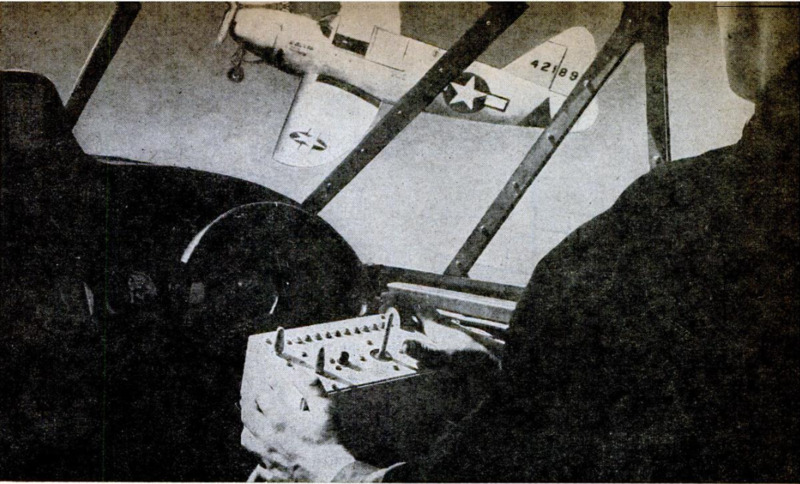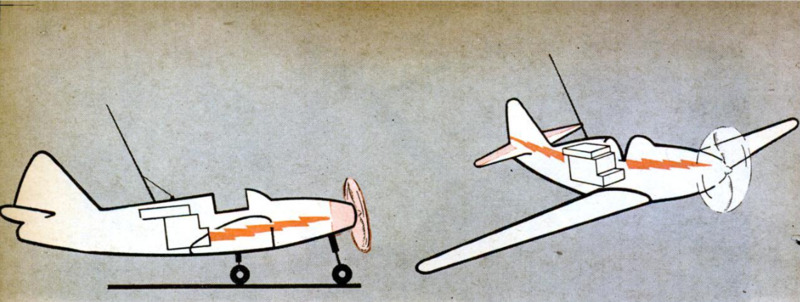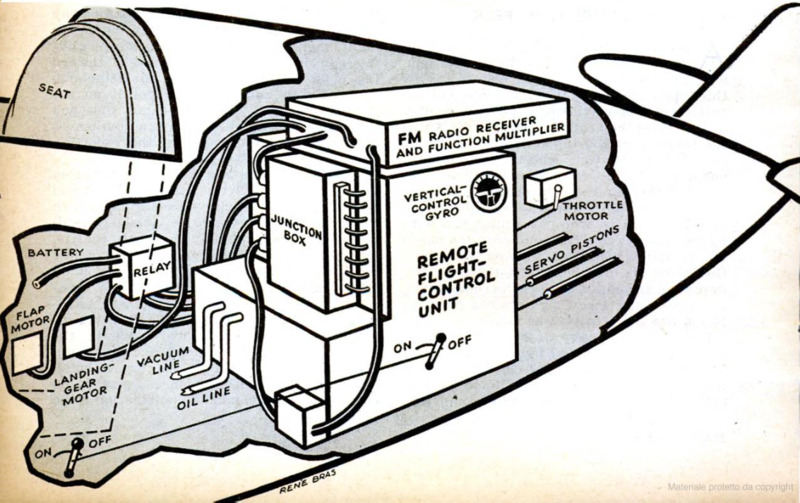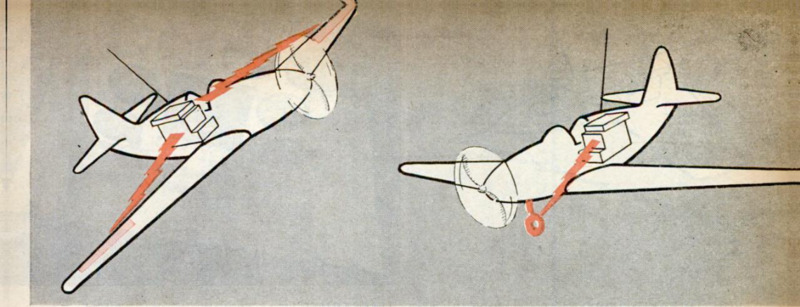-
Title (Dublin Core)
-
Who is Yehudi?
-
Article Title and/or Image Caption (Dublin Core)
-
Title: Who is Yehudi?
-
extracted text (Extract Text)
-
A WAR-WEARY Flying Fortress stag-
gered off an Eighth Air Force airdrome
with the heaviest war load ever lifted by
this type of bomber. It carried only enough
fuel for a one-way trip, a pilot, a copilot,
and a device they called “Yehudi.” This was
the take-off of the top-secret, joint Army-
Navy “Anvil Project,” and the beginning of
one of the war's weirdest air missions.
After the climb to its cruising altitude,
the explosive-filled Fortress was abandoned
by the two pilots, who parachuted safely to
British soil, leaving the bomber in the hands
of “Yehudi”—the little man who isn’t there.
Guided by his invisible hands, the B-17 flew
in perfect formation with the accompanying
Fortresses and escort fighters out over the
North Sea for nearly three hours.
Flak became heavy as they approached
the vital German naval base on Helgoland.
The Forts and fighters climbed several
thousand feet higher and took evasive
action. None was more evasive than that
lone B-17 with the empty cockpit away
below. Suddenly it stopped its weaving in
flight, made several turns in a steep, glid-
ing spiral. Then it dived straight toward
the submarine installations on Helgoland.
The German gunners never got it on the
way down. And they never got that sub
yard back into operation. Concussion waves
from the explosion bounced the escorting
planes at their 30,000-foot altitude.
The push-button warfare continued from
early in 1944 until the very end of World
War II, as war-wearies were crammed with
TNT and a new explosive, which is still
secret, and sent plunging, by remote control,
into a number of German and Japanese
high-priority targets. On each mission an
officer on special duty from the Air Tech-
nical Service Command's Equipment Labo-
ratory—one of the AAF’s most secret in-
stallations at Wright Field—rode in the
copilot’s seat of one of the accompanying
bombers. He carried in his lap a small
aluminum box with which he sent radio
commands to “Yehudi,” a combination radio
receiver and automatic pilot in the con-
trolled plane.
Smaller pilotless craft have been used as
ground and aerial gunnery targets for more
than three years. And the art of radio
piloting has progressed to the point where
“Yehudi” can now replace the pilots of jet
planes and carrier-based Hellcat fighters, or
the test pilots who normally fiy untried,
experimental craft.
This miracle of radio piloting is accom-
plished through the use of an aluminum
“stick box” which is fitted with a miniature
control stick, switches, and indicating lights.
A cable connects this with the FM radio
transmitter and its five-foot, half-wave-
length whip antenna that sends the com-
mands to the 10-channel FM receiver in the
controlled plane. The radio impulses then
go through a “function multiplier” box
where they are “decoded” and passed on to
the remote flight control unit (RFCU)
Here they are translated into motion for the
working of the plane’s controls by means of
hydraulic pistons. ?
You don't have to be a musician to be a
good radio-plane pilot, but it helps. There
is a balanced modulator in the transmitter
hookup that produces eight musical tones
which can be heard through headphones
worn by the operator. Hach of these de-
notes some movement of the plane's con-
trols. Each of the eight amber lights on the
stick box also glows to the tune of some
control function, but the lights are seen
before the tones are heard. When the “turn”
light glows, for example, this indicates that
the circuit is clear for turning action. The
operator hears no tone until he moves the
little stick and the plane begins to turn. The
order is given with the light, and the
“execute” command with the musical tone.
Expert radio-plane pilots rarely wear the
headphones while the plane is within sight.
Really “hot” operators do not even watch
the lights, but concentrate on the controlled
plane itself. Only rated AAF or Navy flyers
are recruited for this musical flying duty,
and it takes an experienced airman about
50 hours to learn how to be a “beep pilot.”
There is no “feel” to radio flying; it is
strictly a matter of air judgment and
finger facility. A safety pilot rides in the
controlled plane to correct the student's
mistakes, and an automatic power valve
enables him to
override the RFCU control action at any
time. Trainees begin their radio flying from
ground stations and fly from a mother
plane during the advanced stage.
The flight-testing of mew experimental
airplanes is one of the newer and more
imaginative applications of radio piloting.
Particularly dangerous maneuvers such as
power spins and terminal-velocity dives,
from which a plane might not recover, can
now be carried out under radio control from
a mother plane or ground station.
The reason for putting a new plane
through these maneuvers is to find out how
it responds, or doesn’t respond, and why.
The instrument readings of a plane under
test usually furnish most of this informa-
tion. Pilots and technicians of the Air
Technical Service Command, Bell Aircraft,
and other commercial firms collaborated a
few months ago in the development of
the YP-59B Airacomet jet fighter. The test
jet is called the “Reluctant Robot.”
A specially equipped mother plane, an-
other Airacomet called the “Mystic Mis-
tress,” is used as a mother plane, and is
probably the only two-seater jet fighter in
America. It can be distinguished from any
other YP-50B jet by the long, swordlike
antenna protruding from the nose and by
the extra cockpit in the cowling ahead of
the regular pilot's cabin. A flight engineer
or observer rides in this extra seat. Instead
of the conventional stick box holding all the
necessary controls, the “Mistress” has the
miniature control stick set into the handle
of the regular pilot's control stick. The
function switches and their indicating lights
are installed in an extra-large handle on
the jet plane’s throttle.
Thus, in putting the “Reluctant Robot”
through its paces, the mother-plane pilot
flies both his ship and the “Robot.”
The instrument readings are televised,
passed on to the transmitter in the test
plane's nose and sent down to the ground
or to the mother plane. Here, the observers
can read the test plane's instruments on a
television screen as well as if they were
flying in the “Reluctant Robot" itself.
Wright Field pilots say that radio-con-
trolled aircraft can now be used for any
purpose piloted planes can fulfill. Although
passengers can hardly be expected to be
intrigued by the idea of flying in pilotless
airliners, there are many other uses to
which “Yehudi” can be put. In war and
peace, he has proved himself a pretty in-
telligent robot.
-
Contributor (Dublin Core)
-
James L. H. Peck (article writer)
-
Language (Dublin Core)
-
Eng
-
Date Issued (Dublin Core)
-
1945-12
-
pages (Bibliographic Ontology)
-
93-95,224
-
Rights (Dublin Core)
-
Public domain
-
Archived by (Dublin Core)
-
Sami Akbiyik
 Popular Science Monthly, v. 147, n. 6, 1945
Popular Science Monthly, v. 147, n. 6, 1945








